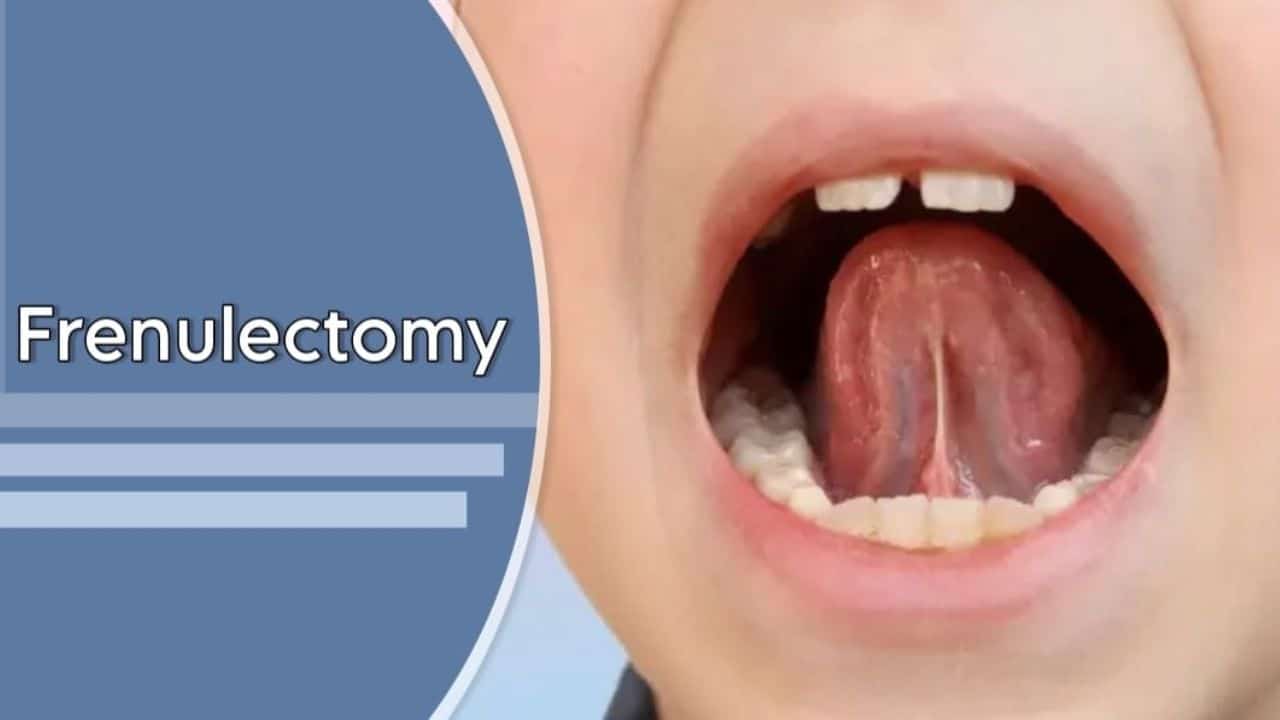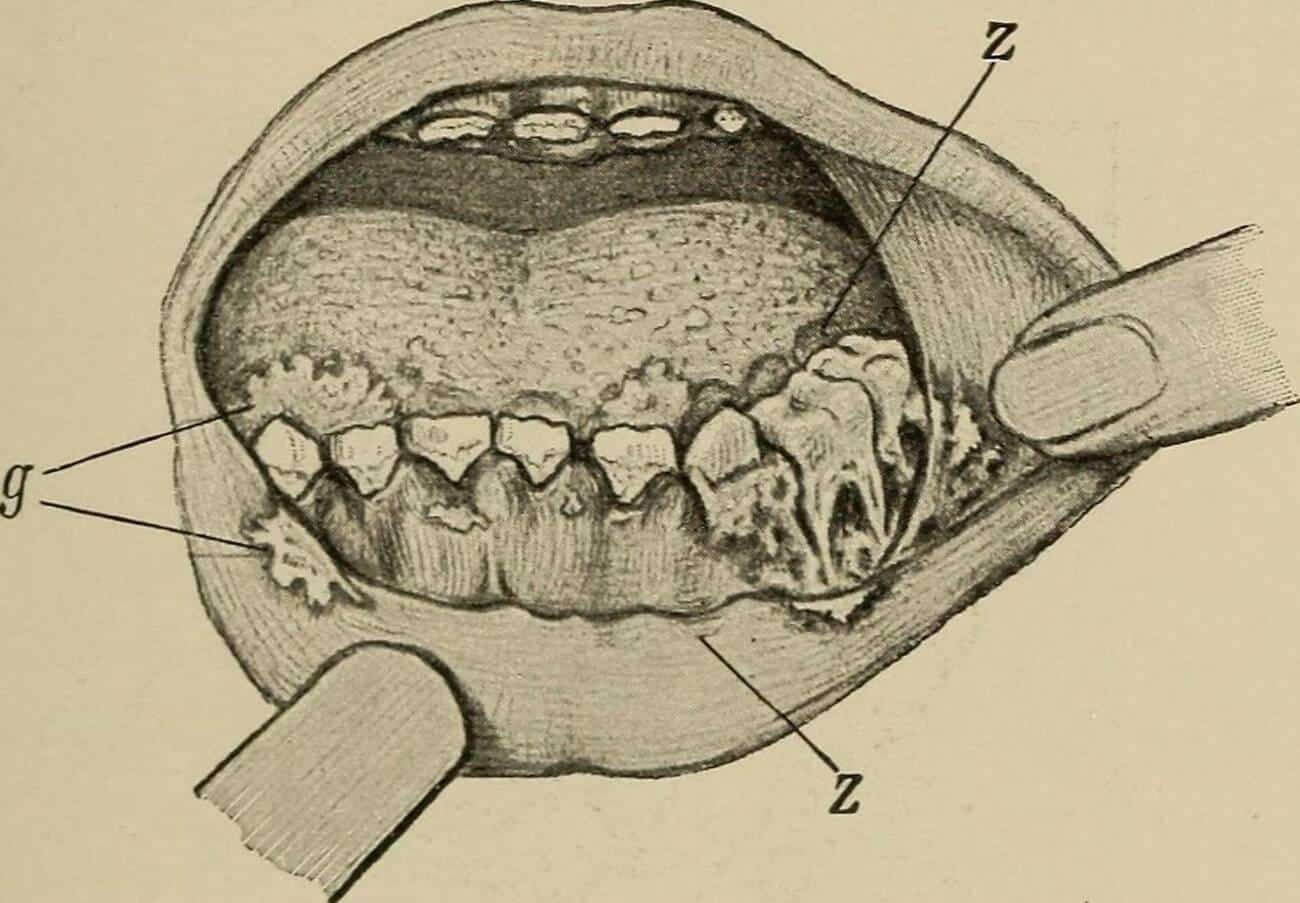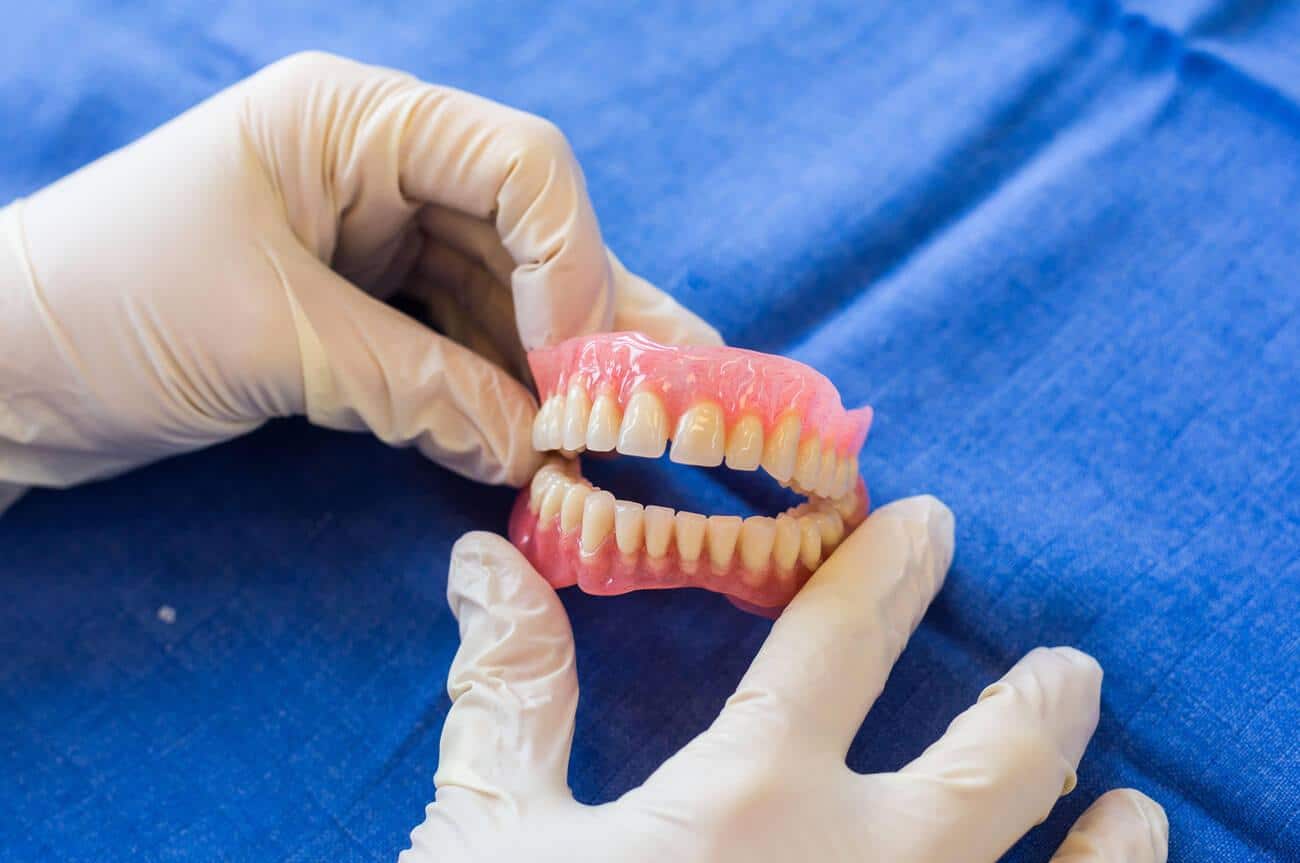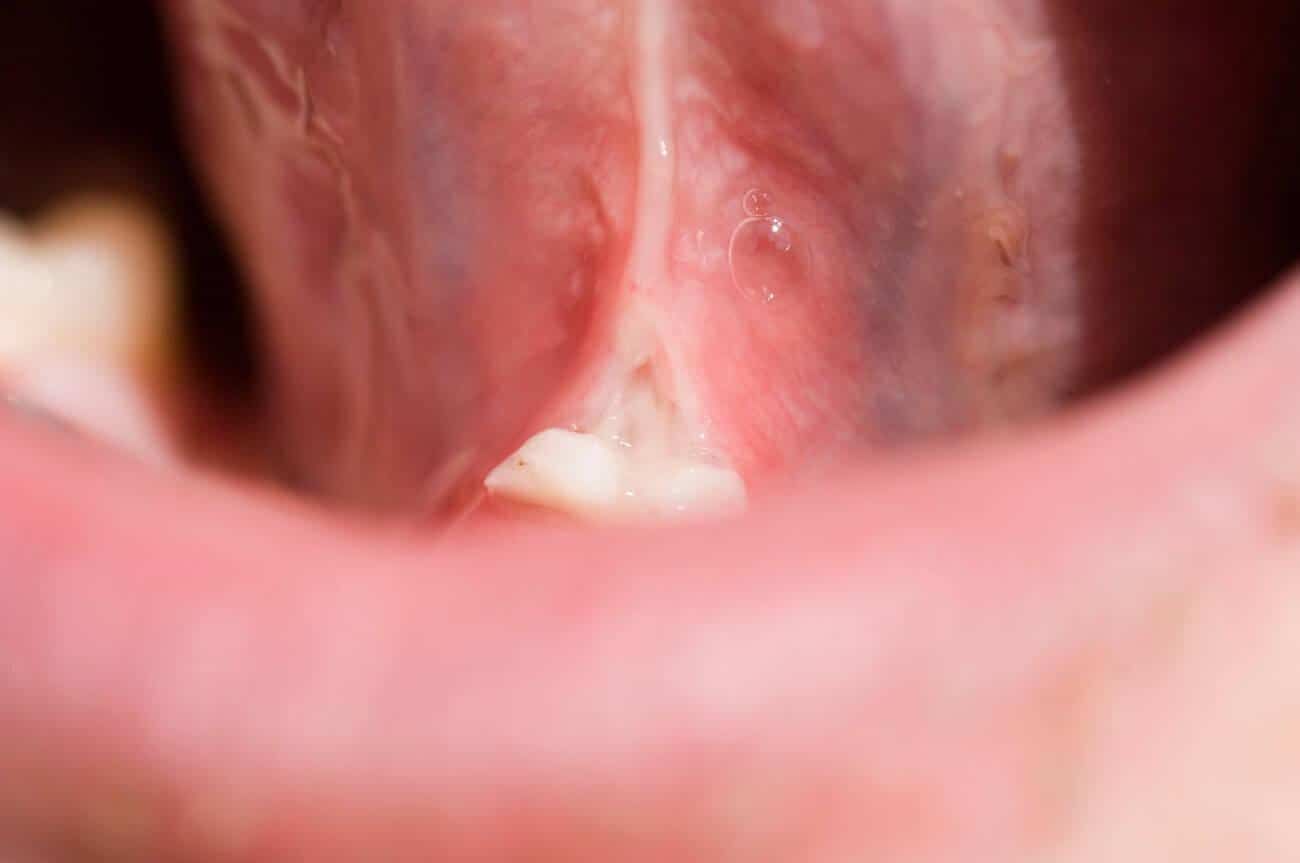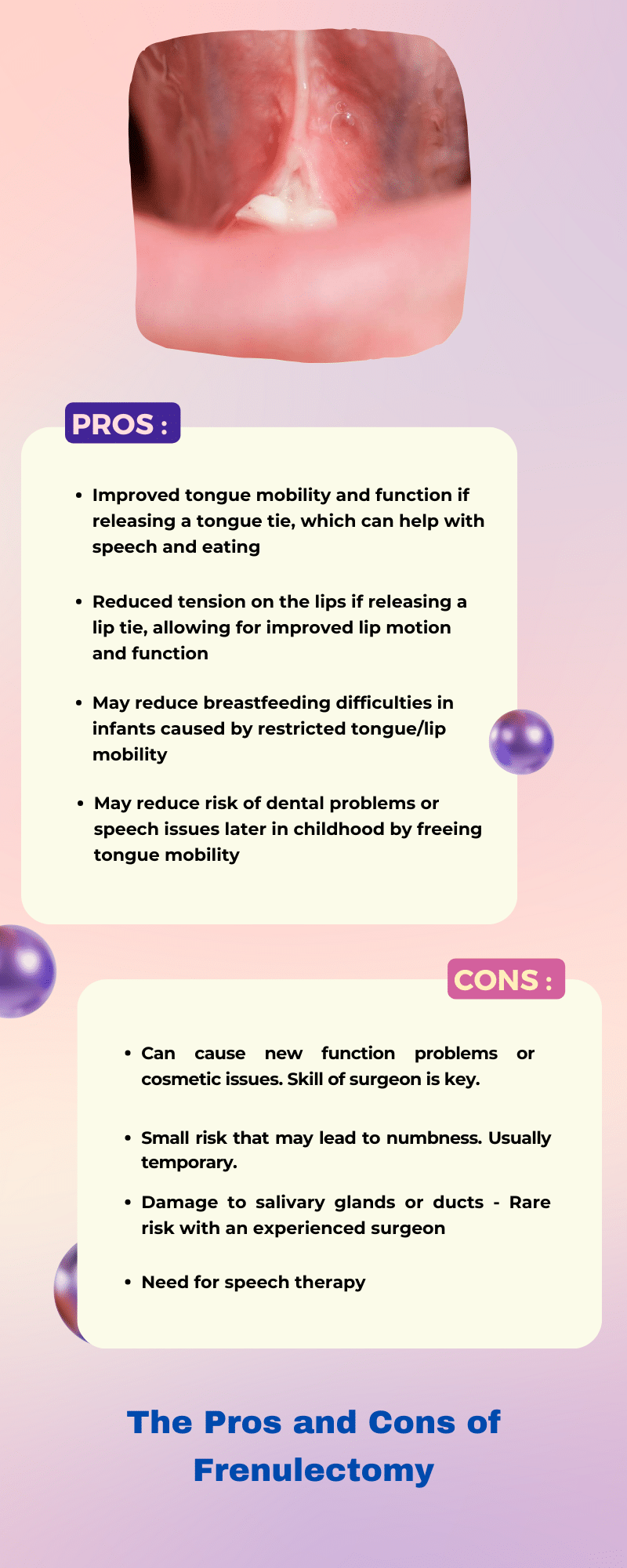Having a frenulum that’s too tight or obstructive can cause difficulty with speaking, eating, and kissing. A Frenulectomy is an oral surgery procedure performed to treat such conditions caused by the abnormal frenulum.
In this article, we’ll debunk the mystery around the Frenulectomy by exploring its indications for both adults and children, procedure details, as well as recovery times, and results from this common operation.
Whether you’re considering a frenulectomy yourself or for your child, understanding what it entails will help you make an informed decision about treatment options.
Content Highlights
- Frenulectomy is an oral surgery procedure used to treat conditions caused by the abnormal frenulum.
- Reasons for having a frenulectomy include jaw pain, difficulty eating/speaking, dental health problems, and difficulties playing instruments.
- This procedure involves cutting away excess fibrotic tissue, which helps reduce discomfort while improving oral health.
- A frenulectomy can also help adjust dentures and improve the quality of life for both adults and children who experience abnormally large or tight frénum attachments in their mouth.
Understanding Frenum: Definition and Functions
A frenum is a fold of tissue that anchors and attaches the lip, cheek, or tongue to the underlying bone.
Definition and Location in the Body
A frenum is a piece of tissue that attaches the cheeks, tongue, or lips to the gum area. It’s located in the inside of the mouth and has different names depending on its exact location: The lingual frenum connects the tongue to the floor of the mouth, while the maxillary labial frenum attaches the gums and upper lip above the upper two front teeth.
Other frena can be found under your chin or between your nose and upper lip. In babies, an unusually thick or short midline lingual (tongue) frenum can impede normal feeding patterns by preventing them from properly suckling breast milk or formula from a bottle.
This phenomenon is often referred to as “tongue-tie,” which tends to resolve itself naturally over time.
Functions of the Frenum
The frenum is a small band of tissue found in the mouth that connects the mouth to teeth, lips, and cheeks. It can be found on either side of the mouth and underneath the tongue. The lingual frenum is found under the tongue, connecting it to the floor of the mouth, while both upper and lower labial frena attach to get gums around the front two top or bottom teeth connecting accordingly.
The frenulum supports the lips, cheek, and tongue’s normal functioning, controlling its movements.
Its major function includes inhibiting any excessive movement that could lead to accidental injury of tissues in the gums. Still, it can also cause problems with common activities like talking, eating, or drinking if too tight or short, which can require a surgical procedure known as “Frenulectomy.”
When Is Frenulectomy Necessary?
[Video Credits @doctors-circle]
A frenulectomy may be necessary when someone experiences jaw pain, difficulty swallowing, dental health problems, difficulties speaking or kissing, trouble playing certain instruments, or denture-related issues.
Jaw Pain
An oversized frenulum can be the underlying source of jaw pain. It may result in difficulty eating, poor dental health, issues with dentures or braces, trouble talking, problems with kissing, and difficulties playing certain instruments.
This is because an overly tight frenum can lead to tension in the jaw area, causing muscle aches and pains that worsen when chewing food. The force generated during normal speech also strains the connective tissue, resulting in jaw discomfort.
Treatment options for this issue include stretching exercises recommended by a healthcare provider and orthodontic treatment. However, more severe cases may require surgery such as a frenulectomy, which gently cuts away excess fibrotic tissue, alleviating discomfort and restoring comfortable daily functioning.
Also Read: Foods to Eat With Toothache
Difficulty Eating
A frenulectomy is a procedure that removes or shortens an oversized or abnormal frenulum, a small band of tissue located at the bottom of the mouth. An abnormally large frenulum can cause difficulty with eating for both children and adults.
An oversized lingual frenum attachment, especially in infants, can restrict tongue movement during nursing and bottle feeding – making it difficult to get sufficient nourishment. Additionally, if left untreated in childhood, it can continue to hinder one’s ability to stick their tongue out far and practice proper speech development.
As an adult, having a high attachment may lead to trouble speaking clearly as well as having difficulty chewing and swallowing food without pain or discomfort. In severe cases, surgery may be indicated in order to help individuals achieve proper oral functioning, which would have otherwise been hindered by enlarged or abnormally placed Frenum attachments.
By performing a Frenulectomy, individuals are able to open their mouths properly for better function when talking, eating, breathing, and playing instruments like wind instruments.
Dental Health Issues
A frenulectomy, also known as a tongue-tie release, can be beneficial for those experiencing dental health issues related to their frenulum. When present in the oral cavity, a misaligned or oversized frenulum can produce problems ranging from difficulty eating and speaking to an increased risk of cavities and other more serious dental conditions such as gum disease.
Additionally, large frenums can cause skin bridging between teeth, leading to difficulties with braces or dentures.
For adults needing treatment for an enlarged or tight frenum beneath the tongue who believe they may have jaw pain due to this condition (which is often worse during certain movements like chewing food), a procedure known as a lingual Frenulectomy might provide relief.
During this type of surgery, laser technology assists in loosening tissue without having to cut it off completely by shortening its length, thus eliminating any potential pulling on both the gums above and below it.
This reduction helps reduce discomfort while improving overall oral health: better blood flow gains access to areas around teeth that had been at high risk for developing cavities in the past due to improper hygiene caused by limited intraoral mobility resulting from tension created by an overly tight/large tissue band (frenum).
Dentures
Dentures play an important role in the dental health and appearance of the patient. However, these dentures come with their own issues when a person has an abnormally large frenulum.
A frenulum is a small band of tissue that connects the inner lip to the gum area, if it becomes enlarged or thickened, it can affect how well dentures fit and function by preventing them from making full contact with both upper and lower gums.
This may lead to problems such as jaw pain, difficulty eating food due to slipping or poor stability, loss of taste sensation due to inadequate chewing surface coverage, poor dental hygiene from improper cleaning around ill-fitting appliances, sore spots on gums that cause discomfort while talking or playing certain instruments, difficulties kissing because of hindered mouth movement, etc.
Thus, a frenulectomy allows for better movement between the top and bottom lips by removing or clipping this excess tissue from within the mouth, allowing for improved stability and function of dentures, resulting in an overall improvement in daily life activities, including right eating habits.
Trouble Talking
For people with an oversized frenulum or lingual frénum, a minor oral surgery known as a frenulectomy can help them communicate more effectively. This procedure, which is also sometimes called a frenotomy or tongue-tie release surgery (though it sounds similar, don’t mix it with lip-tie surgery), helps address difficulty speaking and other issues caused by the overly restrictive nature of an unnecessary tissue in the mouth.
The purpose of this procedure is to allow normal function of the tongue movement and mouth movements.
An overly large and tight lingual frénum can create challenges for those trying to speak clearly, just like braces make it difficult to speak until you’re used to them. It may affect some areas of enunciation and cause certain sounds to be difficult, making it almost impossible for someone to express themselves accurately without frustration with their order’s inability to convey their thoughts properly or efficiently.
Problems With Kissing
Kissing can pose a challenge for some individuals, especially when an overextended frenulum is to blame. A frenum is an elastic band of tissue that connects the upper lip or tongue with the gum and bone underneath.
An oversized frenulum can cause difficulty in optimally separating lips, resulting in difficulties with kissing. Additionally, if the position of the labial frenum causes tension, it could lead to recession of the gums, which could also obstruct comfortable kissing experiences.
In such cases, a formal Frenulectomy treatment becomes necessary where excess fibrotic material causing retraction or stretched tissue will be removed surgically from between two teeth either at the lower front part (for Labial) or the upper back part (for the Lingual area).
It helps improve dental hygiene & space closure-related issues and makes kissing more enjoyable due to optimized positioning of lip separation, allowing both partners’ lips access easily.
A Frenulectomy also offers relief from the pain associated with excessively tight exchange during oral contact activities like eating, drinking & talking, which was earlier up-hearted by tautness because of overstretched tissues connecting respective facial organs in certain parts.
Difficulties with Playing Certain Instruments
Playing certain musical instruments can be difficult or even impossible in persons with over-sized frenulums. These difficulties may include trouble pressing down strings of stringed instruments, producing the right volume when blowing into a wind instrument, or having insufficient control over valves and keys on brass instruments.
An oversized frenulum exerts excess tension on lips and tongue muscles, which can negatively affect an individual’s ability to produce sound correctly while playing these kinds of instruments.
Certain problems, such as a type of disability in speech formant production due to the inability to articulate complex sounds or uncontrolled lip movements, might occur depending on the severity of the condition, causing difficulty in playing some musical instructions such as saxophone, clarinet, trumpets, etc.
Additionally, it may also lead to anticipatory jaw tightness and strain while attempting to properly voice tones from large low notes during vocal exercises, resulting in discomfort and thus limiting one’s own range on pitch levels that they desire working within the comfort zone for their voices genetic boundaries set up by physiology influencing limitations when trying advanced extended ranges that may have been possible without excessive tension influencing involuntary physical mouth phenomena.
Frenulectomy in Adults
Adult frenulectomy can treat a number of conditions, so read on to learn more about the procedure and its indications.
Indications for Adult Frenulectomy
The indications for adult frenulectomy vary depending on the patient’s age and specific presentation. Generally, a frenulectomy is used to correct an abnormally tight frenum that restricts upper jaw or tongue movement.
Adults typically seek this procedure if they experience difficulty with speaking, chewing, and swallowing due to their frenum attachment. Jaw pain resulting from an abnormal position of the labial frenum can also be corrected through a specially tailored surgical procedure.
Adult denture wearers may require a modified version of this procedure in order to ensure the ideal fit and alignment of their dentures. Other common reasons adults opt for this oral surgery include problems with kissing, playing certain instruments like wind or brass instruments, and issues related to dental health (such as gingival recession) caused by an excessive labial attachment or lingual tie size.
Common Reasons for Seeking a Frenulectomy As an Adult
Adults may seek a frenulectomy to address medical problems related to the frenum, such as inhibiting movement, causing difficulties in tasks like talking and eating, hindering development, or resulting in aesthetic issues.
Adults with an oversized frenulum may experience uncommon symptoms beyond those experienced by younger patients. These can include jaw pain exacerbated by activities such as chewing gum and eating crunchy foods, difficulty properly fitting dentures due to the tightness of the tissue below, problems with speaking clearly, inhibited action when playing wind instruments or stringed musical instruments, and even discomfort regarding kissing.
Some adults may pursue a frenulectomy for aesthetic reasons if they’re unhappy about how bulky their tongue appears due to size or its manner of movement while being used for speech.
Frenulectomy In Children
Children may benefit from frenulectomy to correct speech and dental health issues, so parents must be aware of the signs their child may need this surgery. Read further to learn the details about the procedure and its potential risks.
Indications For Pediatric Frenulectomy
Pediatric frenulectomy is a procedure that divides or removes the frenum in order to provide more movement. This is done most commonly in young children to treat tongue-tie, excessive fibrotic tissue, and muscle tension with the goal of ensuring normal development for speech and eating.
Some indications for pediatric frenectomies include excess fibrotic tissue preventing spacing closure between the upper front teeth, tension caused by the position of the labial frenum leading to gum recession, and a high lingual frenum attachment restricting tongue movement.
Additionally, if a child has large frustums located under their tongues (known as tongue-ties), this can result in issues such as difficulty speaking clearly as well as interfering with breastfeeding, and even difficulty sticking out one’s tongue far enough.
Benefits of Early Treatment
Early treatment with frenulectomy can address medical problems related to the frenum. Individuals can enjoy improved overall functionality and development by freeing up more movement.
For example, babies may experience issues with breastfeeding, while children can have difficulty sticking their tongues out far or receding gums as a result of large frenums under the tongue.
Early diagnosis and aggressive treatment of these conditions can help alleviate such issues. In addition, speech impediments that arise from tongue-tie, in particular, may be rectified by performing a frenectomy during infancy or childhood; seeking early treatment has been found to improve feeding issues and significantly reduce incidences of facial malformations present at birth as well.
Signs a Child May Need a Frenulectomy
[Video Credits @Mayo Clinic]
When it comes to indicating a possible need for a frenulectomy in children, there are multiple signs that parents and other caretakers should look out for. One such sign is being tongue-tied; the lingual frenum is too short, restricting tongue movement, so they’ll have difficulty with tasks like sticking their tongue out far.
This can also interfere with speech, as well as making it harder for them to eat or drink certain items without issues arising due to lack of mobility, causing discomfort and pain. Another common reason why children often require a frenulectomy would be if they have receding gums; this could mean that there is an excess fibrotic tissue preventing spacing closure between upper front teeth, which, when found causing dental issues, chances are high it must get removed by using the procedure as seen suitable.
In addition to this, another indicating factor before having surgery maybe if the clinical examination shows that a child has a high lingual attachment Frenulum upon examining restriction, barely allowing any proper range of movement while performing everyday activities like talking freely or drinking properly clear liquid products from cups or bottles, etc.
Frenulectomy Procedure Details
The procedure, referred to as a frenulectomy, is relatively straightforward and typically takes no more than 30 minutes to complete.
Frenulectomy, or frenectomy/frenotomy, is a common oral surgery procedure used to correct abnormal frenula (pieces of soft tissue). The most common types of frenectomies are the lingual or tongue-tie frenectomy and maxillary labial (upper lip) frenectomy.
Lingual frenectomies involve removing or clipping the fibrous band that connects the tongue’s underside to the floor of the mouth. This type of surgery can be used for infants with limited tongue movement due to an abnormally tight attachment between their tongue and bottom jawbone.
It can also be advantageous in adults handled by a subspecialist who suffers from speech, kissing, and eating problems caused by restricted mobility from this tissue.
Maxillary labial frenectomy removes or clips the lower lip’s center attachment at gum level above two front teeth, which causes tension leading to gum recession and other dental health issues; it is not often done on children before adolescence as they require further follow-up treatment options afterwards.
Before, During, and After The Procedure
Before a frenulectomy, your doctor will work with you to review the risks and benefits of the procedure. They may ask you to stop taking any medications or supplements that could increase bleeding during and after surgery.
You may also need blood tests or imaging, such as an MRI. Your mouth will be numbed using an anesthetic to prepare for the procedure. During the procedure, the precise technique used to remove or clip away at tissue varies depending on the reason for surgery and the location of the frenum in question.
Common techniques include sharp excision (using a scalpel) and laser ablation (using CO2 surgical lasers).
Afterward, gauze is applied pressure directly over any incisions while they heal, and antibiotics are prescribed if needed to avoid infection.
Use of Co2 Surgical Lasers
CO2 surgical lasers are a modern and minimally invasive alternative for frenulectomy procedures. CO2 lasers can be used to precisely sever and remove the excess tissues of the frenum that limit movement or cause discomfort while eating, speaking, drinking, or kissing.
The laser works by sending out a beam of light energy, which is absorbed by the tissue instead of cutting it physically with tools. This way, it helps to free up more mobility from this area in a low-risk outpatient procedure without any collateral damage inside the mouth.
The use of CO2 surgical lasers also ensures less post-op pain as compared to traditional techniques due to bloodless incisions and minimal trauma caused to surrounding structures like gums, muscles, arteries, etc. Furthermore, recovery times following these procedures tend to be reduced tremendously, allowing patients who go through them quicker to return to their daily activities, ensuring no disruption in life.
Risks and Benefits of Frenulectomy
Before proceeding with a frenulectomy, it is important to consider the potential risks versus benefits of undergoing the procedure.
Advantages of a Frenulectomy
A frenulectomy can provide a range of potential benefits for both adults and children. This procedure can reduce jaw pain, improve eating and speaking abilities, help with dental issues such as overcrowding of teeth or tongue thrusting due to the attachment of the frenum, assist with dentures and braces or other orthodontic treatments, allow for more comfortable kissing, and facilitate playing certain instruments like the flute or saxophone.
In children, this surgery helps resolve breastfeeding problems caused by an overly attached frenum. Therefore, it promotes better oral development during childhood through normal suckling action from airway clearance, stimulating healthy muscle growth in cheeks and jaws.
With fewer restrictions come improved mouth movements that make daily activities like talking less challenging and more accommodating to various functions normally done with the mouth, such as whistling and tongue twisters.
Potential Risks and Complications
Frenulectomy, like any other oral surgery, can come with risks and potential complications. Possible post-operative effects include bleeding, infection, scarring of the area around the frenum that was removed or clipped, decreased sensitivity in the mouth (especially if performed on the lingual frenulum), allergic reaction to anesthesia and pain medications, and nerve damage resulting from incorrect clipping or excessive force.
While rarer than general side effects associated with a frenulectomy procedure, these risks should be discussed thoroughly with a healthcare professional prior to undertaking any such operation.
In addition to post-operative effects, lifelong changes are associated with a successful procedure – including increased mobility of tissue near affected areas due to the removal of tensile bonds between muscles, which can cause teeth misalignments over time without preventative measures in place.
Recovery and Outlook
The recovery time for a frenulectomy may vary depending on the individual’s particular circumstances. Still, typically, most patients are able to return to their normal routine within one or two weeks.
Patients should remain attentive, and any signs of complications should be reported as soon as possible.
Typical Recovery Time
The typical recovery time following a frenulectomy procedure varies depending on the individual and the extent of the procedure. In general, most patients are able to resume normal activities within a few days after surgery.
Pain and discomfort after surgery are typically mild. Still, they can be managed with over-the-counter pain medications such as ibuprofen or acetaminophen in order to alleviate any discomfort that might occur. In rare cases, you might feel pain in your gum for multiple reasons, including post-frenulectomy.
Additionally, it is important to follow post-operative instructions provided by your surgeon, such as eating soft foods for several days, refraining from certain activities while healing occurs, caring for sutures properly if present, etc.; this will help ensure proper healing with minimal disruption and reduce your risk of complications following the operation.
Returning to Normal Activities
Once the frenulectomy procedure has been successfully completed, patients can typically return to normal activities in a few days. Frenulectomy is an outpatient procedure, so there’s no need for hospital stays and overnight recovery.
The typical recovery timeframe can vary depending on the patient and the type of procedures performed; however, for most patients, it usually takes 1-2 weeks to recover from the surgery fully.
In some cases, general anesthesia may be required during teen and adult frenectomy procedures, which could lead to a longer recovery period. Those who have had general anesthesia must be careful while going back to their normal daily routine as they may still experience grogginess or drowsiness due to anesthesia effects even after several days of the surgery.
Patients should not rush into everyday physical activities soon after receiving frenectomy treatment; otherwise, this may result in slow healing time and increased risk of infection at incision sites or other complications related to nerve damage near affected areas like lips, tongue, and cheeks.
Depending on the severity of work done during surgery, a dentist may suggest soft food items such as soup, yogurts, etc, instead of hard solids like burgers. After sufficient rest, the dentist will likely give a go-ahead signal for returning to action with light exercises such as swimming.
How Long Until Eating and Drinking Is Comfortable
Typically, after a frenulectomy procedure, it will take 3-4 days to recover and experience relief from discomfort before eating or drinking. Some individuals may find that they are able to drink immediately after the surgery but delay eating solid food for at least 24 hours until inflammation and swelling subside.
Only soft foods can be consumed in the first few weeks post-surgery, such as purees, smoothies, soups, and mashed vegetables, while the surgical site heals. It is during this time frame when taking smaller bites of softer items rather than large quantities of hard items like meat or crunchy snacks.
Other factors that can affect how quickly an individual returns to normal levels of comfort when consuming usual solids/liquids include pain tolerance, age (children versus adults), physical condition prior to procedure (strength & nutrition), and skill level of the surgeon performing operation.
Follow-Up Care
Follow-up care is an important part of the frenulectomy procedure. Generally, a follow-up appointment will be scheduled with the oral surgeon within one to two weeks, which may be conducted via phone or video conferencing.
At this visit, the oral surgeon observes healing and determines if further intervention is necessary. Follow-up care includes monitoring for complications such as infection and recurrence of symptoms previously experienced before surgery.
Depending on the extent of the procedure, it may involve dietary changes or activities like smoking and drinking alcohol being avoided. Regular checkups allow those affected to communicate any change in their condition effectively so that quick treatments can be provided if needed while also informing them how long until eating and drinking are comfortable again after a frenulectomy has been performed.
Read Also: How to Keep Your Teeth and Gums Healthy?
When to Call the Doctor?
Knowing the signs of complications and scheduling follow-up care are important steps for a successful recovery from a frenulectomy procedure.
Complications from a frenulectomy may include difficulty talking, issues with dentures or braces, and trouble kissing or playing certain instruments. A patient should carefully monitor their condition for any of these symptoms post-surgery, as they can indicate difficulties related to the frenectomy procedure.
If any of such signs emerge immediately after the surgery, it is important to contact a healthcare professional right away in order to receive prompt evaluation and treatment.
Though complications following a frenulectomy are rare, they have been known to occur in some cases stemming from reflexive muscle responses occurring at the surgical site. Loss of sensation on the part of the tongue near where the tissue was excised could also result from damage done during more invasive forms of this procedure, such as those using dental lasers.
Takeaway
Undergoing a frenulectomy is an effective procedure that can relieve various issues caused by abnormal frenulum attachments. Removing excess fibrotic tissue alleviates discomfort and supports improved oral function.
For both children and adults who experience restricted tongue mobility, speech impediments, challenges with oral hygiene, or other problems due to their frenulum, this straightforward surgery can greatly enhance their quality of life.
With a skilled oral surgeon, the procedure involves minimal risks, and complications are rare when proper aftercare instructions are followed. Full recovery takes approximately 1-2 weeks.
Consult a qualified dentist or orthodontist if your child suffers from an overly tight or thick frenulum. They can examine the frenulum and determine if frenulectomy is recommended for your specific situation.
While initially daunting, this routine procedure has proven successful for many patients of all ages plagued by a problematic frenulum. Taking the step to undergo frenulectomy can improve your mouth’s comfort, function, and confidence.
Disclaimer: This content is for informational purposes only and does not replace professional medical advice, diagnosis, or treatment. This information is not comprehensive and should not be used to make health or well-being decisions. Consult a qualified healthcare professional with questions about a medical condition, treatment options, or health regimen. This website or the content should never replace professional medical advice.


